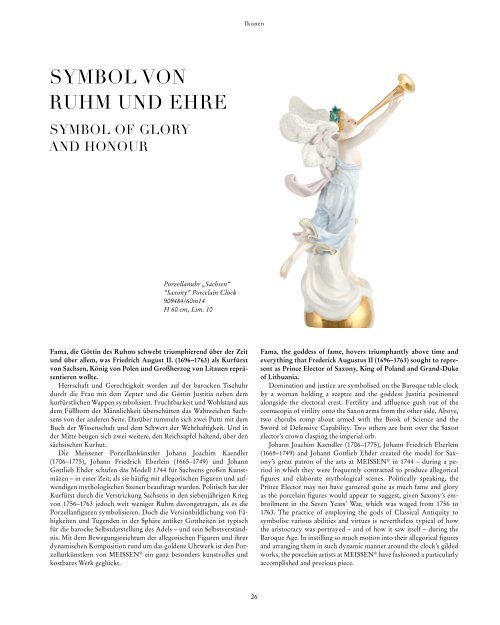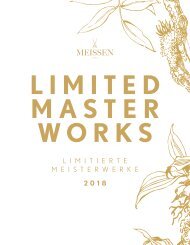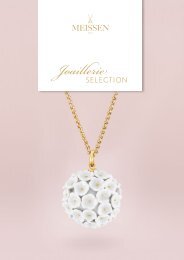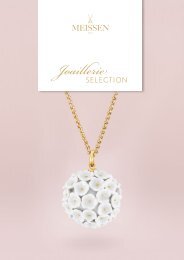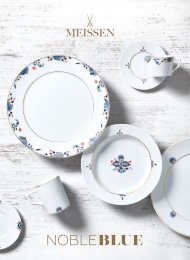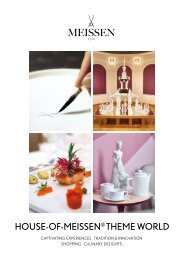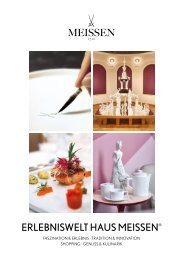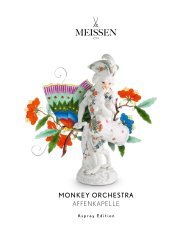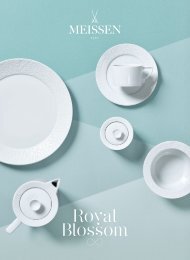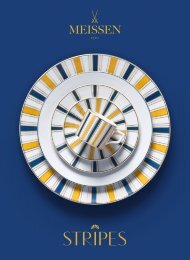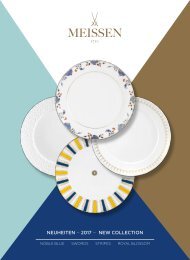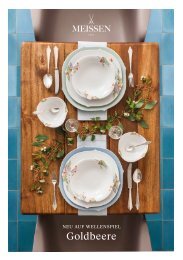MEISSEN LIMITIERTE KUNSTWERKE 2014
Kunst und Können, Ausdauer und Arbeitswillen, Liebe zum Detail und Leidenschaft für ein jahrhundertealtes Kunsthandwerk – all das müssen die Künstler von MEISSEN® mitbringen, um aus edlem Porzellan kostbare Sammlerstücke für die Ewigkeit zu erschaffen. --- Art and ability, endeavour and endurance, loving attention to detail and a passion for centuries-old works of art – these are just some of the attributes that MEISSEN® artists require in order to create priceless collector’s items in porcelain for posterity.
Kunst und Können, Ausdauer und Arbeitswillen, Liebe zum Detail und Leidenschaft für ein jahrhundertealtes Kunsthandwerk – all das müssen die Künstler von MEISSEN® mitbringen, um aus edlem Porzellan kostbare Sammlerstücke für die Ewigkeit zu erschaffen.
---
Art and ability, endeavour and endurance, loving attention to detail and a passion for centuries-old works of art – these are just some of the attributes that MEISSEN® artists require in order to create priceless collector’s items in porcelain for posterity.
Sie wollen auch ein ePaper? Erhöhen Sie die Reichweite Ihrer Titel.
YUMPU macht aus Druck-PDFs automatisch weboptimierte ePaper, die Google liebt.
Ikonen<br />
SYMBOL VON<br />
RUHM UND EHRE<br />
SYMBOL OF GLORY<br />
AND HONOUR<br />
Porzellanuhr „Sachsen“<br />
“Saxony” Porcelain Clock<br />
909484/60m14<br />
H 60 cm, Lim. 10<br />
Fama, die Göttin des Ruhms schwebt triumphierend über der Zeit<br />
und über allem, was Friedrich August II. (1696–1763) als Kurfürst<br />
von Sachsen, König von Polen und Großherzog von Litauen repräsentieren<br />
wollte.<br />
Herrschaft und Gerechtigkeit werden auf der barocken Tischuhr<br />
durch die Frau mit dem Zepter und die Göttin Justitia neben dem<br />
kurfürstlichen Wappen symbolisiert. Fruchtbarkeit und Wohlstand aus<br />
dem Füllhorn der Männlichkeit überschütten das Wahrzeichen Sachsens<br />
von der anderen Seite. Darüber tummeln sich zwei Putti mit dem<br />
Buch der Wissenschaft und dem Schwert der Wehrhaftigkeit. Und in<br />
der Mitte beugen sich zwei weitere, den Reichsapfel haltend, über den<br />
sächsischen Kurhut.<br />
Die Meissener Porzellankünstler Johann Joachim Kaendler<br />
(1706–1775), Johann Friedrich Eberlein (1665–1749) und Johann<br />
Gottlieb Ehder schufen das Modell 1744 für Sachsens großen Kunstmäzen<br />
– in einer Zeit, als sie häufig mit allegorischen Figuren und aufwendigen<br />
mythologischen Szenen beauftragt wurden. Politisch hat der<br />
Kurfürst durch die Verstrickung Sachsens in den siebenjährigen Krieg<br />
von 1756–1763 jedoch weit weniger Ruhm davongetragen, als es die<br />
Por zellanfiguren symbolisieren. Doch die Versinnbildlichung von Fähigkeiten<br />
und Tugenden in der Sphäre antiker Gottheiten ist typisch<br />
für die barocke Selbstdarstellung des Adels – und sein Selbstverständnis.<br />
Mit dem Bewegungsreichtum der allegorischen Figuren und ihrer<br />
dynamischen Komposition rund um das goldene Uhrwerk ist den Porzellankünstlern<br />
von <strong>MEISSEN</strong> ® ein ganz besonders kunstvolles und<br />
kostbares Werk geglückt.<br />
Fama, the goddess of fame, hovers triumphantly above time and<br />
every thing that Frederick Augustus II (1696–1763) sought to represent<br />
as Prince Elector of Saxony, King of Poland and Grand-Duke<br />
of Lithuania.<br />
Domination and justice are symbolised on the Baroque table clock<br />
by a woman holding a sceptre and the goddess Justitia positioned<br />
alongside the electoral crest. Fertility and affluence gush out of the<br />
cornucopia of virility onto the Saxon arms from the other side. Above,<br />
two cherubs romp about armed with the Book of Science and the<br />
Sword of Defensive Capability. Two others are bent over the Saxon<br />
elector’s crown clasping the imperial orb.<br />
Johann Joachim Kaendler (1706–1775), Johann Friedrich Eberlein<br />
(1665–1749) and Johann Gottlieb Ehder created the model for Saxony’s<br />
great patron of the arts at <strong>MEISSEN</strong> ® in 1744 – during a period<br />
in which they were frequently contracted to produce allegorical<br />
figures and elaborate mythological scenes. Politically speaking, the<br />
Prince Elector may not have garnered quite as much fame and glory<br />
as the porcelain figures would appear to suggest, given Saxony’s embroilment<br />
in the Seven Years’ War, which was waged from 1756 to<br />
1763. The practice of employing the gods of Classical Antiquity to<br />
symbolise various abilities and virtues is nevertheless typical of how<br />
the aristocracy was portrayed – and of how it saw itself – during the<br />
Baroque Age. In instilling so much motion into their allegorical figures<br />
and arranging them in such dynamic manner around the clock’s gilded<br />
works, the porcelain artists at <strong>MEISSEN</strong> ® have fashioned a particularly<br />
accomplished and precious piece.<br />
26


